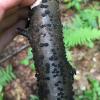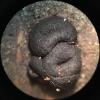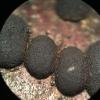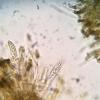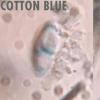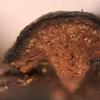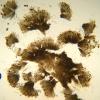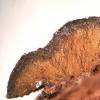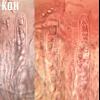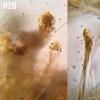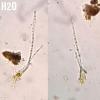
20-12-2025 23:08
Patrice TANCHAUDBonsoir, récolte sur sol sablonneux dans l'arri�

21-12-2025 09:32
Hello.A tiny ascomycete found embedded in wood in

20-12-2025 15:47
Mirek GrycHi.These grew on pine wood that was heavily covere

18-12-2025 21:17
Pol DebaenstThe identification took me to Byssonectria deformi

15-12-2025 07:09
 Danny Newman
Danny Newman
indet. Rutstroemiaceae sp. on unk. fallen leavesMc

19-12-2025 10:10
Patrice TANCHAUDBonjour, récolte réalisée en milieu dunaire, a

18-12-2025 17:23
 Bruno Coué
Bruno Coué
Bonjour,je serais heureux d'avoir votre avis sur c
Black pulvinate asco on Prunus
Ethan Crenson,
26-08-2017 15:56
Hans-Otto Baral,
26-08-2017 16:08

Re : Black pulvinate asco on Prunus
Hi Ethan
Remarkable fungus! I am not sure if the asci stand in a hymenium at the surface of these ascomata or if they are in cavities, i.e., perithecia in a stroma. Do you have survey photos of a section that perhaps show such cavities?
The ionomidotic KOh reaction reminds of a Codieritidaceae
Zotto
Remarkable fungus! I am not sure if the asci stand in a hymenium at the surface of these ascomata or if they are in cavities, i.e., perithecia in a stroma. Do you have survey photos of a section that perhaps show such cavities?
The ionomidotic KOh reaction reminds of a Codieritidaceae
Zotto
Ethan Crenson,
26-08-2017 22:10
Re : Black pulvinate asco on Prunus
Zotto,
In the fourth photo I tried to show a cross section of two ascomata. As you can see there is a distinct dark layer at the surface and light brown tissue in the interior. However, I don't detect perethecia in the black layer. I am including a closer version of one of the section photos here.
I can't find Codieritidaceae in Google. If there's a typo, I'm afraid I can't figure it out.
Ethan
In the fourth photo I tried to show a cross section of two ascomata. As you can see there is a distinct dark layer at the surface and light brown tissue in the interior. However, I don't detect perethecia in the black layer. I am including a closer version of one of the section photos here.
I can't find Codieritidaceae in Google. If there's a typo, I'm afraid I can't figure it out.
Ethan
Hans-Otto Baral,
26-08-2017 22:18

Re : Black pulvinate asco on Prunus
Sorry, it is Cordieritidaceae. It is a vast group of encoelioid discomycetes.
I would prefer doing a thin section for transmitted light, and also to show the paraphyses.
It may be important too to look whether the ascus tip gets thick-walled in the dead state (after shortly heating the slide or adding MLZ or KOH).
I would prefer doing a thin section for transmitted light, and also to show the paraphyses.
It may be important too to look whether the ascus tip gets thick-walled in the dead state (after shortly heating the slide or adding MLZ or KOH).
Ethan Crenson,
26-08-2017 22:27
Hans-Otto Baral,
27-08-2017 07:20

Re : Black pulvinate asco on Prunus
Yes, it looks like a hymenium covering the whole exterior. I see dark olive dots on the hymenial surface which probably represent exudate on the paraphysis tips, could you supply a photo with oil immersion showing thse tips? I assume in KOH this exudate gets dissolved as well?
What also shows the ionomidotic reaction is the genus Dermea. This should contain crystals in the medulla and angular cells in the ectal excipulum.
What also shows the ionomidotic reaction is the genus Dermea. This should contain crystals in the medulla and angular cells in the ectal excipulum.
Ethan Crenson,
29-08-2017 06:51
Re : Black pulvinate asco on Prunus
Otto,
Yes, the exudate on the paraphysis tips dissolves in KOH. In the photos provided here you can see the paraphyses, both covered in the exudate and naked. I've also tried to find the features of asci in the dead state and the exipulum that you mentioned, but I'm not sure if I succeeded.
Thank you for your help,
Ethan
Yes, the exudate on the paraphysis tips dissolves in KOH. In the photos provided here you can see the paraphyses, both covered in the exudate and naked. I've also tried to find the features of asci in the dead state and the exipulum that you mentioned, but I'm not sure if I succeeded.
Thank you for your help,
Ethan
Hans-Otto Baral,
29-08-2017 07:34

Re : Black pulvinate asco on Prunus
Yes, this looks good enough to make up one's mind. The apical thickening of the asci is clearly visible, also I think I see many crystals in the excipulum. The latter would clearly exclude a Cordieritidaceae and support that this is a Dermea.
When I go with Groves' (1946) key in Mycologia 38: 364, then I arrive at the common Dermea cerasi. Ascus and spore size fits well (dead asci in KOH are certainly smaller than the living ones you have measured). Only the anamorph is missing, but anyway I am sure.
Zotto
When I go with Groves' (1946) key in Mycologia 38: 364, then I arrive at the common Dermea cerasi. Ascus and spore size fits well (dead asci in KOH are certainly smaller than the living ones you have measured). Only the anamorph is missing, but anyway I am sure.
Zotto

